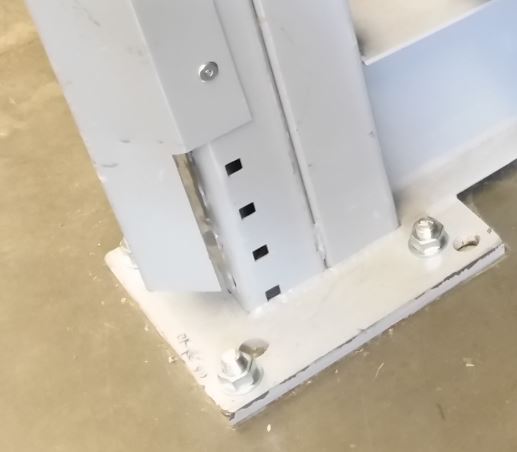The ASCE7 Specification is the document that the International Building Code refers to for applied loading for design of structures. Storage rack are covered in chapter 15 of the ASCE7. Section 15.5.3.2 of the ASCE7-10 Specification requires a modification to the ANSI/RMI Specification that includes the following statement:
Design forces that include seismic loads for anchorage of steel storage racks to concrete or masonry shall be determined using load combinations with over-strength provided in Section 12.4.3.2 of ASCE/SEI 7. The over-strength factor shall be taken as 2.0.
This basically means that the anchors are to be designed for double the computed uplift effect or ΩE where Ω = 2. This requirement would mean baseplates and anchors would have to be upsized to the point where the column base design is impractical. There is an option that is also contained within the ASCE7 Specification (Section 12.4.3.1). It reads as follows:
Emh = Ωo Qe
Qe is the effect of the horizontal forces and Ωo = the over-strength factor (Ωo = 2).
EXCEPTION: The value of Emh need not exceed the maximum force that can develop in the element as determined by a rational, plastic mechanism analysis or nonlinear response analysis utilizing realistic expected values of material strengths.
For the design of a baseplate and anchors the element being referred to is the baseplate. So a simpler step-by-step way to state all of the above would be:
Step 1: Compute the seismic uplift effect at the base, Qe. The baseplate and anchors must always resist at least this amount of uplift. The total uplift the anchors are required to take considering over-strength would be the lessor of:
a.) The uplift required to develop a plastic mechanism in the baseplate but not less than 1 x Qe.
b.) Double the uplift effect (2 x Qe.)
To comply with the over-strength design requirement the rack designer must choose either a.) or b.), above. If the computed seismic uplift effect (Qe) is small enough the designer will often choose option b.), then just make sure the anchors and baseplate are capable of carrying 2 x Qe. However, when the computed seismic uplift effect is larger the increase in baseplate and anchors may be extreme and option a.), will be chosen. By careful configuration of the baseplate and anchors a baseplate can be selected so a “plastic mechanism” will develop at an uplift value that is between 1 x Qe and 2 x Qe.
For example:
A storage rack is evaluated for cross-aisle seismic and the computed seismic uplift effect Qe = 5 kips. The designer chooses option a.). The designer configures the thickness of the baseplate geometry of the baseplate, the location of the anchors, etc. so the baseplate develops a “plastic mechanism” at an uplift of 6.0 kips. Based on the exception in ASCE7 12.4.3.1 anchors may be selected to resist 6.0 kips of seismic uplift rather than the 10.0 kips that would be required if option b.), had been chosen. The baseplate strength must be computed using the expected yield strength rather than the specified minimum yield strength.
Often in order to achieve a plastic mechanism using option a.), the thickness of the baseplate is reduced from the normally very thick baseplates that had been traditionally specified before this over-strength requirement was introduced into the ASCE7. The initial reaction to the thinner baseplate for those who have seen thick baseplates for years is to question the reason for the reduced thickness because using the thinner plate seems counter-intuitive.
The purpose of the over-strength requirement is to avoid brittle fracture of the anchors or the concrete slab region surrounding the anchors. Seismic energy is best absorbed by ductile elements rather than brittle elements.
The next edition of the ANSI/RMI Specification hopefully will address this over-strength issue so the ANSI/RMI exception can be removed from future editions of the ASCE7. For further questions regarding this requirement contact UNARCO Engineering.
